Best Practices for PLCM: Platform Life Cycle Management
Platform Life Cycle Management Best Practices
“Building Profits through Simplification, Standardization, Speed, and Scale”
A White Paper by the University of Tennessee Global Supply Chain Institute
More Information on this White Paper
What's Inside
“PLCM is often referred to as a common sense strategy by supply chain leaders.”
Supply chains have grown exponentially more complex, placing immense pressure on organizations to maintain efficiency, meet customer demands, and remain competitive in the global marketplace.
Consumers are demanding more amid increasing complexities but are unwilling to pay more for their ever-increasing expectations. This means that supply chain leaders are forced to manage increasingly challenging operations without the benefit of additional revenue, often with the same resources they have always had.
So, how can supply chain professionals navigate this maze of complexity and emerge with efficient, cost-effective operations? Best-in-class companies are finding solutions by adopting an old but proven strategy: Platform Life Cycle Management (PLCM). Initially developed in the 1920s to revolutionize the automotive industry, PLCM is now being applied in new ways to help modern companies simplify and streamline their supply chains.
The Global Supply Chain Institute (GSCI) at the University of Tennessee’s Haslam College of Business conducted a study of 14 leading organizations that are using PLCM to cut through supply chain challenges and complexity. These companies apply PLCM to simplify product design, standardize processes, and create more efficient end-to-end supply systems. Their solutions provide valuable insights and defined supply chain best practices for other organizations seeking to overcome similar challenges.
Download this white paper to explore:
- • Essential definitions, history, and context
• PLCM processes and best practices
• Case studies
• A PLCM supply chain best practices reference list
• PLCM capability assessment resources
The concepts behind PLCM are straightforward, but implementing them requires strong leadership and a commitment to driving change. Building a high-performing PLCM culture will test your organization’s ability to adapt and innovate, but the rewards are worth the effort.
For supply chain managers and executives ready to take the next step, the full white paper offers insights, practical tools, and best practices to help you implement PLCM in your organization. Download the white paper to explore the full range of strategies and examples from leading companies that are using PLCM to transform their supply chains and navigate the complexities of the modern global economy.
For more in-depth, industry-focused white papers from the Global Supply Chain Institute (GSCI) at the University of Tennessee, Knoxville, visit this web page. Recent papers produced by the Advanced Supply Chain Collaborative, an initiative of GSCI, engage industry experts and UT faculty to explore and report on advanced concepts in supply chain management and innovation, including supply chain agility, last-mile and reverse logistics, and more.
Who This White Paper is Primarily For: Supply Chain Managers, Supply Chain Planners, Corporate CEOs, Supply Chain Professionals, Chief Supply Chain Officers, Chief Procurement Officers, Supply Chain Leaders, and Supply Chain Students.
